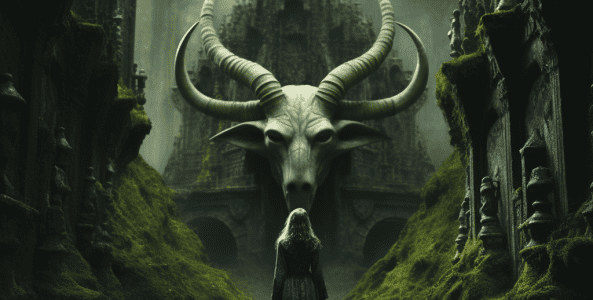Guillermo del Toro’s 2006 masterpiece, “Pan’s Labyrinth” (also known as “El Laberinto del Fauno”), is an unforgettable cinematic journey that combines elements of magic realism, Greek mythology, and Lewis Carroll’s “Alice in Wonderland”. Set in post-Civil War Spain, the film takes viewers on a dark fantasy adventure where the boundaries between reality and imagination blur.
Magic Realism:
The film prominently features magic realism, an artistic movement that seamlessly blends ordinary and extraordinary elements. In “Pan’s Labyrinth”, the protagonist, Ofelia, discovers an alternate underworld that coexists with the brutal reality of postwar Spain. Ofelia’s reading of fairy tales to her fellow prisoners in the dense forests sets the stage for the juxtaposition of reality and magic that permeates the film. The opening scene, where Ofelia reads in the woods, perfectly captures this mood, immersing viewers in the historical context and harsh conditions of the time.
At the heart of the film is the Faun, a central figure of this magic realism who embodies its transformative qualities. Ancient and otherworldly, the Faun guides Ofelia through an intricate labyrinth filled with mythical creatures and challenging tasks. Characters similar to the Faun can be found in the works of Gabriel Garcia Marquez and Isabel Allende, renowned authors associated with magic realism. The Faun’s presence blurs the lines between reality and fantasy, prompting viewers to question whether what they are witnessing is truly happening or a creation of their own minds.
Greek Mythology: “Pan’s Labyrinth” draws heavily from Greek mythology for inspiration. Even the title, “El Laberinto del Fauno”, alludes to the myths surrounding the Minotaur and the Labyrinth of Knossos. Throughout the film, the labyrinth serves as both a physical and psychological challenge, reminiscent of Theseus navigating his way through the maze to confront the Minotaur.
Ofelia’s tasks assigned by the Faun mirror Greek myths in various ways. Her initial mission of retrieving a key from a giant toad’s stomach mirrors the labors of Hercules, while her final task of sacrificing herself to open the gateway to the underworld echoes themes of sacrifice and rebirth found in Greek legends.
Captain Vidal, Ofelia’s abusive stepfather, personifies the characteristics of the tragic hero archetype seen in Greek tragedies. His obsession with power and control recalls that of King Creon from Sophocles’ “Antigone”. Vidal’s pursuit of order stands in stark contrast to Ofelia’s experiences in the alternate dimension, highlighting the eternal tension between the two.
“Alice in Wonderland” Influence: Guillermo del Toro’s love for “Alice in Wonderland” is evident in the whimsical and surreal elements of “Pan’s Labyrinth”. Ofelia’s adventures through the magical labyrinth parallel Alice’s experiences in Wonderland. Both heroines are young girls who encounter strange realms filled with intriguing challenges.
The Faun shares similarities with Lewis Carroll’s iconic Cheshire Cat in terms of appearance and storytelling function. In both works, they provide guidance and test the resolve of the protagonists, offering mysterious advice. Additionally, the labyrinthine worlds in both stories share the theme of things not being as they seem at first glance.
“Pan’s Labyrinth” is a cinematic triumph that seamlessly combines magical realism, Greek mythology, and “Alice in Wonderland.” Guillermo del Toro’s captivating storytelling takes audiences on an extraordinary journey through a dark yet enchanting world where reality and fantasy collide. By drawing inspiration from these sources, the film transcends genre boundaries and becomes a timeless exploration of the human psyche, the power of imagination, and mythical magic.


